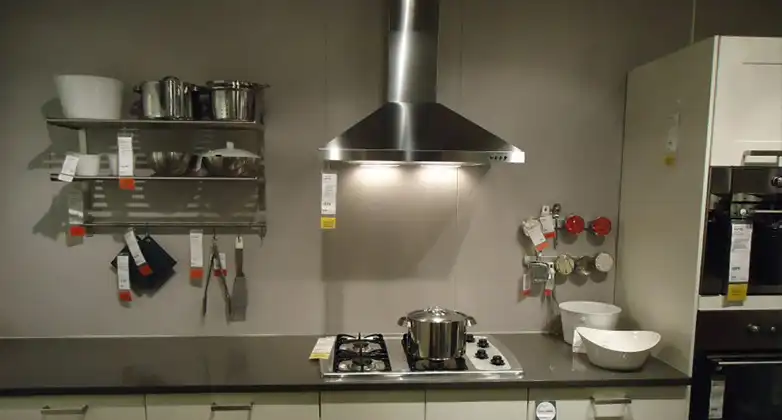The kitchen is the heart of any home, and it’s essential to strike a balance between functionality and aesthetics when designing this space. One crucial aspect of kitchen design is the placement of the cooker hood relative to the overhead cupboards. Should there be a gap between the cooker hood and cupboards?
Yes, there should be a gap between a cooker hood and cupboards to allow for proper ventilation and to prevent heat and steam damage.
In this article, we will explore this question in great detail, discussing the reasons for having a gap, its recommended size, and the potential downsides of not having one.

Should There Be a Gap?
As you might have already guessed, there should be a gap between the cooker hood and cupboards. However, to understand why you need to keep the gap, you need to learn the purpose of the gap.
Heat Dissipation
Cooking generates a considerable amount of heat, especially when using stovetops or ovens. The gap between the cooker hood and cupboards allows heat to disperse effectively, preventing the buildup of excessive heat that can damage cabinets and other kitchen elements. This heat dissipation is crucial for both the longevity of your kitchen components and your comfort while cooking.
Steam and Odor Removal
One of the primary functions of a cooker hood is to capture and remove steam and cooking odors from the kitchen. The gap ensures that the hood can effectively pull in these elements, preventing them from spreading throughout the kitchen and the rest of the home. Without a gap, the cooker hood’s performance may be compromised, leading to lingering odors and moisture.
Maintenance and Cleaning
Maintaining and cleaning your cooker hood is essential for its longevity and performance. A gap provides easy access to the area behind and above the cooker hood, making it simpler to clean and service the appliance. Without a gap, these maintenance tasks can become more challenging, potentially leading to a decrease in the cooker hood’s effectiveness over time.
How Much Gap is Ideal Between the Cooker and the Cupboard?
Now that you know why there should be a gap, let’s learn how much gap is ideal.
Industry Standards
Industry standards recommend a gap of at least 600mm (approximately 24 inches) between the cooker hood and the cupboards. This measurement ensures that the cooker hood can function optimally and that heat, steam, and odors are effectively captured and removed.
Customization
While industry standards provide a general guideline, the size of the gap can be customized to suit your kitchen design preferences and the specific requirements of your cooker hood. However, it’s crucial to consult with a professional designer or installer to ensure that any customization still allows for proper functionality.
What Are the Downsides of Not Having the Gap?
Many homeowners often ask us, “What if I don’t keep any space between the cupboards and the cooker hood?” Well, you shouldn’t, and here’s why:
Reduced Efficiency
The most significant downside of not having a gap between the cooker hood and cupboards is reduced efficiency. Without the necessary space, the hood may struggle to capture heat, steam, and odors effectively, leading to a less comfortable cooking environment and potential health hazards.
Aesthetic Compromises
While it’s possible to eliminate the gap for a sleeker look, doing so can result in aesthetic compromises. The absence of a gap can make the kitchen appear cramped and visually unbalanced. Achieving a harmonious and visually appealing kitchen design may be more challenging without this separation.
Maintenance Challenges
Maintenance and cleaning can become more challenging without a gap. Accessing the space behind and above the cooker hood can be cumbersome, potentially leading to neglect and decreased appliance performance over time. This can result in more significant maintenance and repair costs in the long run.
Can I eliminate the gap altogether for a sleeker look?
Yes, it is possible to eliminate the gap between the cooker hood and cupboards for a sleeker look. However, doing so may compromise the efficiency of the cooker hood and create aesthetic imbalances in the kitchen.
Can I install a filler panel instead of a gap?
While it is possible to install a filler panel between the cooker hood and cupboards, this may not provide the same benefits as a gap in terms of heat dissipation and effective steam and odor removal. Filler panels are primarily for aesthetic purposes.
Are there alternatives to traditional cooker hoods?
Yes, there are alternatives to traditional cooker hoods, such as downdraft ventilation systems and recirculating hoods. These alternatives may have different requirements regarding gaps and installation, so it’s essential to consult with a professional when choosing an option that suits your kitchen.
Can a gap affect the resale value of my home?
The presence or absence of a gap between the cooker hood and cupboards may not be a significant factor in determining the resale value of your home. However, a well-designed and functional kitchen can enhance the overall appeal of your property, potentially positively impacting its market value.
In Summary
Whether there should be a gap between the cooker hood and cupboards in your kitchen is not just a matter of aesthetics but also functionality and efficiency. The gap serves essential purposes, such as heat dissipation, steam and odor removal, and ease of maintenance. While there is room for customization, it’s essential to strike a balance between your design preferences and the functional requirements of your cooker hood. Ultimately, a well-planned gap can contribute to a more comfortable and visually pleasing kitchen space.


![Read more about the article [4 Fixes] Why Won’t My Range Hood Fan Turn Off?](https://kitchenhoodcare.com/wp-content/uploads/2023/05/Why-Wont-My-Range-Hood-Fan-Turn-Off-300x161.webp)
![Read more about the article [Explained] What Is the Temperature of the Kitchen Hood Exhaust?](https://kitchenhoodcare.com/wp-content/uploads/2023/03/What-Is-the-Temperature-of-the-Kitchen-Hood-Exhaust-300x161.webp)